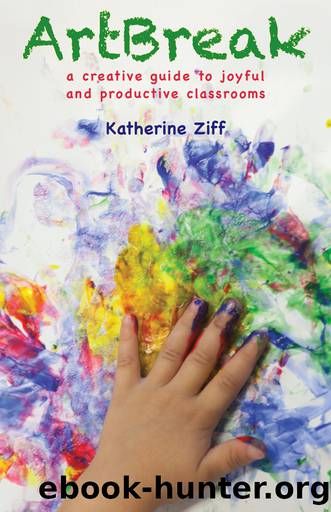ArtBreak by Ziff Katherine;

Author:Ziff, Katherine; [Ziff, Katherine]
Language: eng
Format: epub
Publisher: Ohio University Press
Published: 2016-09-15T00:00:00+00:00
Robots made by the author and displayed alongside child-made robots at a public library exhibit. Photos by Matthew Ziff
Several of my own robots are pictured here. Seeing the childrenâs robot creations was so exciting I had to make some of my own in my home studio.
Offer mask making later rather than earlier in a series of ArtBreak sessions. Children can make and ornament cardboard and fabric masks. You can also purchase inexpensive plastic mask-forms and children can cover them with strips of plaster gauze, available from art-supply stores. The gauze is dipped in water and then applied to the mask form. When the masks dry they can be removed from the forms, painted and ornamented.
Practice exercise: Assemble a roll of plaster gauze, a bowl of water, and a plastic mask-form. Cut small (1" x 2â4") pieces of the gauze. One by one, dip them into water and place them on the mask, building the mask up until it is at least two layers thick. You can add texture and shape to the eyebrows, mouth, forehead, or any other part of the mask. Children revel in sculpting details like cigars, horns, and big eyebrows. These masks are generally too fragile to wear, but they can be made ready for hanging by adding holes on the sides, while still damp, with an awl. Set the mask to dry; this will take two or three days. Then it is ready to pop off the form and ornament. You can add paint inside and out, sequins, buttons, ribbons, natural materials collected outdoors, feathers, and nuts and boltsâthe sky is the limit. Use hot glue or a clear school glue for attaching these items.
Clay, depending on the type, can be a resistive or fluid medium. Unless you have access to a kiln or an oven, use air-dry modeling clay, which is usually resistive and requires some strength to use. You can purchase quite inexpensively a packet of wooden tools for working clay and also collect tools for carving and pressing designs into the clay; these include combs, forks, hardware, and wires. To cut portions of a large block of clay, use wire, each end of which you should secure to a pencil by wrapping the wire ends around the pencils. Holding the pencils, slice the clay with the wire. Playdough is a much less resistant clay option. As a more fluid medium, it is not as well suited for construction, but it can provide a soothing and expressive kinesthetic experience. As with finger paint, clay can evoke unpleasant memories for some children who have experienced certain kinds of trauma, so it is especially important to allow children to choose whether or not they use clay.
Practice exercise: Make up the recipes for no-cook playdough in the resources section at the back of this book, and assess whether you have the equipment and space to support children making up batches at school themselves.
Sewing Materials
Midyear in a school is a good time to introduce hand sewing to ArtBreak groups.
Download
This site does not store any files on its server. We only index and link to content provided by other sites. Please contact the content providers to delete copyright contents if any and email us, we'll remove relevant links or contents immediately.
The Art of Coaching Workbook by Elena Aguilar(50131)
Trainspotting by Irvine Welsh(21052)
Twilight of the Idols With the Antichrist and Ecce Homo by Friedrich Nietzsche(18312)
The Secret History by Donna Tartt(18236)
All the Missing Girls by Megan Miranda(14810)
Cat's cradle by Kurt Vonnegut(14785)
Ready Player One by Cline Ernest(14036)
Talking to Strangers by Malcolm Gladwell(12899)
Fangirl by Rainbow Rowell(8808)
The Compound Effect by Darren Hardy(8531)
Thirteen Reasons Why by Jay Asher(8477)
The remains of the day by Kazuo Ishiguro(8419)
Periodization Training for Sports by Tudor Bompa(7937)
Tools of Titans by Timothy Ferriss(7833)
Wonder by R. J. Palacio(7750)
The Lover by Duras Marguerite(7596)
Change Your Questions, Change Your Life by Marilee Adams(7393)
A Court of Wings and Ruin by Sarah J. Maas(7289)
The Complete Stick Figure Physics Tutorials by Allen Sarah(7154)
